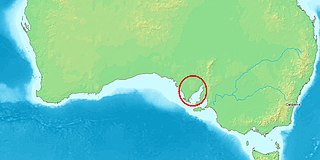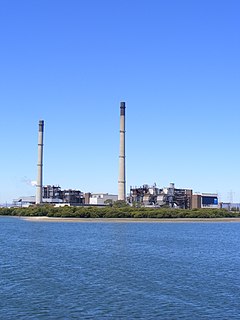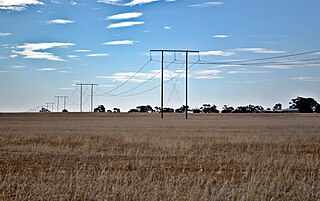Related Research Articles

Whyalla was founded as "Hummocks Hill", and was known by that name until 1916. It is the fourth most populous city in the Australian state of South Australia after Adelaide, Mount Gambier and Gawler. As at June 2018, Whyalla had an urban population of 21,742, having declined at an average annual rate of -0.75% year-on-year over the preceding five years. It is a seaport located on the east coast of the Eyre Peninsula and is known as the "Steel City" due to its integrated steelworks and shipbuilding heritage. The port of Whyalla has been exporting iron ore since 1903.

The Spencer Gulf is the westernmost and larger of two large inlets on the southern coast of Australia, in the state of South Australia, facing the Great Australian Bight. It spans from the Cape Catastrophe and Eyre Peninsula in the west to Cape Spencer and Yorke Peninsula in the east.

The first railway in colonial South Australia was a horse-drawn tramway from the port of Goolwa on the Murray River to an ocean harbour at Port Elliot in 1854. Today the state has 1,600 mm broad gauge suburban railways in Adelaide, a number of country freight lines, as well as key 1,435 mm standard gauge links to other states.

Port Broughton is a small South Australian town located at the northern extent of the Yorke Peninsula on the east coast of Spencer Gulf. It is situated about 170 km north-west of Adelaide, and 56 km south of Port Pirie. At the 2011 census, the town of Port Broughton had a population of 1,034.
Airlines of South Australia refers to

Moomba is a company town located in the Australian state of South Australia within the gazetted locality of Gidgealpa about 770 kilometres (480 mi) north of the state capital of Adelaide. It is operated by Santos Limited for the purpose of exploration and processing of natural gas found in and recovered from the Cooper and Eromanga Basins.

Torrens Island Power Station is located on Torrens Island, near Adelaide, South Australia and is operated by AGL Energy. It burns natural gas in eight steam turbines to generate up to 1,280 MW of electricity. The gas is supplied via the SEAGas pipeline from Victoria, and the Moomba Adelaide Pipeline System (MAPS) from Moomba in the Cooper Basin. The station is capable of burning either natural gas or fuel oil. It is the largest power station in South Australia and was formerly the largest single power station user of natural gas in Australia.

The SEA Gas pipeline(South East Australia Gas pipeline) is a 687 km natural gas pipeline from the Iona Gas Plant near Port Campbell in Victoria to the Pelican Point Power Station at Port Adelaide. It connects Adelaide's gas supply to sources from Victoria's Otway Basin, thus increasing the security of natural gas supply to Adelaide. The pipeline is owned and operated by South East Australia Gas Pty Ltd who are owned in a 50-50 partnership by APA Group (Australia) and the Retail Employees Superannuation Trust.

The Cooper Basin is a Permian-Triassic sedimentary geological basin in Australia. The basin is located mainly in the southwest part of Queensland and extends into north eastern South Australia. It is named after the Cooper Creek which is an ephemeral river that runs into Lake Eyre. For most of its extent, it is overlain by the Eromanga Basin. It covers 130,000 km².

Port Bonython is the location of a deepwater port, gas fractionation plant and diesel storage facility west of Point Lowly in the Upper Spencer Gulf region of South Australia. It lies 16 km east-northeast of Whyalla, South Australia and approximately 370 km north-west of the State's capital city, Adelaide. The existing wharf is 2.4 kilometres long and is capable of berthing small Capesize ships with a maximum capacity of 110,000 tonnes. The wharf was established in 1982 and named after John Bonython, the founding chairman of Santos Limited. The structure is leased to Santos by the South Australian Government and is used for the export of hydrocarbon products. An oil spill at Port Bonython in 1992 resulted in loss of bird life and damage to mangrove habitats to the west and southwest of Port Pirie.

The Whyalla Steelworks is a fully integrated steelworks and the only manufacturer of rail in Australia. Iron ore is mined in the Middleback Range to feed the steelworks, resulting in the distribution of finished steel products of over 90 different grades. It occupies a 1,000 ha site on the shore of False Bay, Spencer Gulf and is the largest employer in Whyalla, South Australia.

The Pelican Point Power Station is located at Pelican Point, 20 km from the centre of Adelaide, South Australia on the Lefevre Peninsula. It is operated by Engie, which owns 72 per cent of the power station. Mitsui owns the remaining 28 per cent. It burns natural gas in a combined cycle power station, comprising two 160 MW gas turbines and one 165 MW steam turbine, to generate up to 485 MW of electricity.

Francis Joseph "Frank" Condon was a trade unionist and Labor politician in South Australia.
Hallett Power Station is located in Canowie, in the Mid North of South Australia, located about 210 kilometres (130 mi) north of Adelaide. It was commissioned in 2001 and opened in 2002. It was built by AGL Energy, but was sold in 2007, and is currently operated by EnergyAustralia. It has capacity of approximately 200 megawatts (270,000 hp), and connects to the National Electricity Grid. It contains 12 gas turbine generators.
The Riverland Pipeline System is a natural gas transmission pipeline supplying gas to the Riverland region of South Australia. It is owned by Australian Gas Networks and operated by the APA Group. The pipeline was built in 1995 by South Australian Gas Company and transferred to Envestra when it was privatised in 1997. The pipeline is a buried steel pipeline with nominal outside diameter of 114.3 millimetres (4.50 in) with 3.0 millimetres (0.12 in) wall thickness. The Maximum Allowable Operating Pressure is 10,000 kilopascals (1,500 psi). Most of the pipe is buried to a depth of 600–900 millimetres (24–35 in) but it is deeper and has thicker walls in areas of high risk such as under road crossings.

Reeves Plains Power Station is a proposal from Alinta Energy to build a gas-fired power station at Reeves Plains between Gawler and Mallala in South Australia. The proposed site borders both the Moomba-Adelaide gas pipe and an electricity transmission line. The power station is proposed to use six gas turbines to produce up to 300 megawatts (400,000 hp) of electricity. It is expected to be operated as a peaking plant rather than running full time. The primary source of fuel will be the gas pipeline, however the plant will also be able to operate on diesel fuel, and will have diesel storage on site. Stage 1 is expected to only be two or three of the turbines, generating 100 to 150 MW of electricity. The power station was originally expected to take 12 months to build, and be commissioned in January 2019. An extension of time request granted an additional 12 months in February 2019, but as of November 2019, the Alinta board had not yet decided to make the investment.
Dry Creek Power Station is a power station at Dry Creek in the northern suburbs of Adelaide, South Australia. It is owned and operated by Synergen Power, a joint venture of Engie and Mitsui. The power station has three open cycle gas turbines, each rated at 52MW. It was commissioned in 1973–1974 by the Electricity Trust of South Australia.

The Amadeus Gas Pipeline is a bi-directional natural gas pipeline running north–south through the Northern Territory of Australia. Its southern extent is the Amadeus Basin gas fields west of Alice Springs. The Amadeus pipeline is owned and operated by APA Group, and regulated by the Australian Energy Regulator.
The South West Queensland Pipeline (SWQP) is a bidirectional natural gas transmission pipeline in southern Queensland. It was built in 1996 to carry gas 755 kilometres (469 mi) from the Ballera gas plant to the gas trading hub at Wallumbilla. The western end was later extended in 2008 by 182 kilometres (113 mi) to Moomba. The original section is also known as the Ballera to Wallumbilla Pipeline System, and the extension as the Queensland/South Australia/New South Wales (QSN) Link. In 2014 the combined system was reconfigured to be bidirectional.
Epic Energy is an Australian company that owns gas pipelines and wind farms. It has been a wholly owned subsidiary of QIC Global Infrastructure, an arm of the Queensland Investment Corporation, since 2013.
References
- 1 2 3 "Moomba to Adelaide Pipeline System (MAPS), South Australia". Epic Energy. Archived from the original on 25 February 2021. Retrieved 16 May 2016.
- ↑ "SA: Moomba to Adelaide Pipeline System". Australian Energy Market Commission . Retrieved 17 May 2016.
- ↑ "South Australia - Transmission: Moomba to Adelaide Pipeline System". Australian Energy Market Commission . Retrieved 17 May 2016.
- ↑ "SA: Moomba to Adelaide Pipeline System". AEMC.
- ↑ Alinta Energy (8 November 2017). "Application on Notification" (PDF). South Australian Planning Commission, Department of Planning, Transport and Infrastructure. 312/V005/17. Retrieved 11 November 2017.